University of Rochester
ABSTRACT
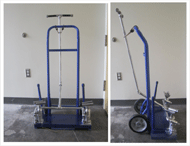 AMTAC
AMTAC
BACKGROUND
 Figure 1
Figure 1
The device we have designed will be useful to individuals who rely on wheelchairs for transportation but participate, or wish to participate, in an adaptive cycling program. It will also be useful to the individuals providing assistance during the transfer process. Table I and Table II contain the needs and wants that have been used as a guideline to developing this device. Attaining a minimum height differential between the wheelchair seat and the hand cycle seat, and eliminating the rear cycle wheel as a transfer obstacle are two of the main customer needs. The device must be able to hold and lift the weight of an individual as well as improve the safety of the transfer process for all those involved.
PROBLEM STATEMENT
Our device aims to create an environment in which the transfer from a wheelchair to a hand cycle via a slide board is safer and easier for both the individual being transferred and those assisting in the transfer.
CUSTOMER
This project was brought to us by SportsNet, which is an adaptive recreation program in Rochester, NY. We are working specifically with their adaptive cycling program and based our design requirements off of their wants and needs which can be seen below in Table I and Table II . Although these are our initial customers we believe that the AMTAC device would be a great asset to any adaptive cycling program similar to SportsNet, as well as to individuals. Table I and Table II also list our proposed testing plan to determine if all the design requirements were met. At this point only two of these tests have been completed, however they are the tests necessary to prove that the device is safe and functional and were therefore considered the most significant to development.
| Need | Metric | Acceptable Range | Proposed Test |
|---|---|---|---|
| Ability to adjust height level of seat | Length (in) | +/- 8 in | Raise and lower the seat to different heights. |
| Ability to hold and lift weight of person | Weight (lb) | >300 lb | Test device with different weights in seat to 300 lbs. |
| Safety (No tipping) | Weight (lb) | >300 lb | Test different weights at different positions until tipping occurs. |
| Does not tip on uneven ground | Weight (lb) | >300 lb | Same tipping test but with device and bike set up on uneven ground. |
| Low manufacturing cost | %Cost of bike | <15% | Calculation at end of project, no physical test required |
| Portable | Yes/No | Yes | Survey a panel of possible users (transfer assistants). |
| Wheel is consistently replaced correctly | Yes/No | Yes | How much force is needed to attach the quick release wheel |
| Want | Metric | Acceptable Range | Proposed Test |
|---|---|---|---|
| Durability (used year-round or stored during winter) | Time (years) | > 5 years | Would need to conduct long term testing after manufacturing with yearly safety checks. |
| Compatible with different cycle or seat models | Yes/No | Yes | Do all related safety checks with different bike models. |
| Easy to use | Duration of complete transfer (min) | <5 minutes | Time transfer with actual users after other safety criteria are met. |
| # Steps to prepare for biking | 1-5 | Count number of steps required | |
| # People other than user required for transfer | 1 | Survey actual users once safety criteria are met. | |
| Force required to raise seat with user (lbs) | ≤40 lbs | Measure force required to raise lift with maximum weight in seat using scale. Also, measure time required to raise seat completely with or without weight. |
DESIGN ALTERNATIVES
Several design concepts were considered in developing the most appropriate solution to the customer problem. To determine which idea most effectively addressed our customer needs, a design selection matrix was developed that is weighted to reflect the importance of each selection criterion. Three ideas were evaluated and compared to the current method of a slide board transfer. The design selection matrix is shown below.
- Pump under seat: A cylinder pump permanently installed within the hand cycle on a plate attached to the lower frame with the top of the pump attached to the base of the seat for lifting.
- Lift under cycle with removable wheel: This device would be completely separate of the cycle and latch onto the bottom frame of the cycle for transfer. Jacks would then lift the entire cycle so that the seat is in the correct position. This idea does not individually address the issue of the cycle wheel, so it would need to be used in conjunction with a quick release wheel or a device that allows easy removal of one of the rear wheels.
- Air cushion: This would involve placing an inflatable device onto the seat (whether under, over or incorporated into the seat cushion) that will inflate for the transfer process and deflate for riding position.
| Proposed Prototypes | Current Method | ||||
|---|---|---|---|---|---|
| Selection Criteria | Max Score | Pump under seat | Lift under cycle with removable | Air cushion incorporated into seat | Slide board |
| Adjust height of seat at least 6 inches | 10 | 10 | 10 | 10 | 0 |
| Back Cycle tire is not in the way of transfer | 8 | 8 | 10 | 8 | 2 |
| Raise and lower weight of user | 10 | 10 | 10 | 10 | 0 |
| Safety: stable during entire transfer process | 10 | 10 | 7 | 5 | 8 |
| Safety: slide board is level during both transfers | 10 | 8 | 10 | 8 | 3 |
| Ease of use: time necessary for transfer | 5 | 4 | 3 | 1 | 3 |
| Ease of use: Number of helpers needed | 5 | 3 | 2 | 3 | 4 |
| Added weight to cycle is small | 5 | 1 | 5 | 3 | 8 |
| Added height to seat in riding position is small | 5 | 3 | 5 | 3 | 8 |
| Ease of installation | 4 | 1 | 3 | 4 | 2 |
| Compatible with different cycle models | 4 | 1 | 3 | 4 | 2 |
| Ease of manufacturing | 8 | 4 | 6 | 6 | 4 |
| durability | 8 | 5 | 5 | 6 | 3 |
| total | 100 | 73 | 82 | 76 | 52 |
| Rank | 2 | 1 | 1 | 3 | |
| Continue? | N | Y | N | N | |
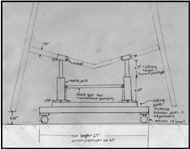 Figure 2
Figure 2
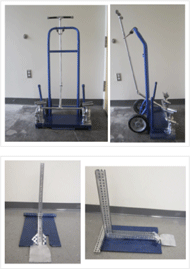 Figure 3
Figure 3
RESULTS
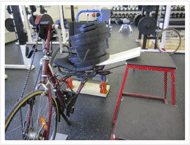 Figure 4
Figure 4
- Where the slide board and the wheelchair seat overlap
- In the middle of the slide board.
- Where the edge of the hand cycle seat and the slide board overlap.
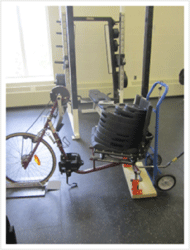 Figure 5
Figure 5
FUTURE IMPROVEMENTS
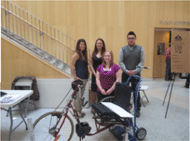 Design Team
Design Team
REFERENCES
Xiang, H., Chany, A., & Smith, G. (2006). Wheelchair Related Injuries Treated in US Emergency Departments. Injury Prevention , 8-11.
ACKNOWLEDGMENTS
Dr. Amy Lerner
Dr. Scott Seidmen
SportsNet – Anita O’Brien and Johnny Fahner-Vitelic
Art Salo